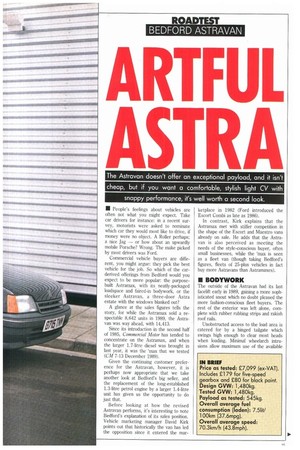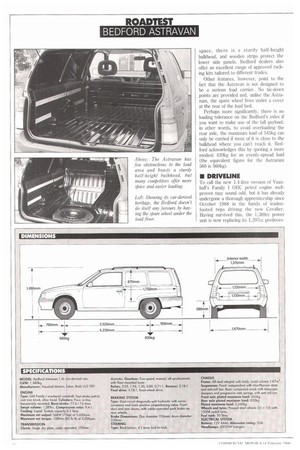ARTFUL ASTRA
Page 45

Page 46

Page 47

Page 48

If you've noticed an error in this article please click here to report it so we can fix it.
• People's feelings about vehicles are often not what you might expect. Take car drivers for instance: in a recent survey, motorists were asked to nominate which car they would most like to drive, if money were no object. A Roller perhaps; a nice Jag — or how about an upwardly mobile Porsche? Wrong. The make picked by most drivers was Ford.
Commercial vehicle buyers are different, you might argue: they pick the best vehicle for the job. So which of the carderived offerings from Bedford would you expect to be more popular: the purposebuilt Astramax, with its neatly-packaged loadspace and faired-in bodywork, or the sleeker Astravan, a three-door Astra estate with the windows blanked out?
A glance at the sales figures tells the story, for while the Astramax sold a respectable 8,642 units in 1989, the Astravan was way ahead, with 14,413.
Since its introduction in the second half of 1985, Commercial Motor has tended to concentrate on the Astramax, and when the larger 1.7-litre diesel was brought in last year, it was the 'max that we tested (CM 7-13 December 1989).
Given the continuing customer preference for the Astravan, however, it is perhaps now appropriate that we take another look at Bedford's big seller, and the replacement of the long-established 1.3-litre petrol engine by a larger 1.4-litre unit has given us the opportunity to do just that.
Before looking at how the revised Astravan performs, it's interesting to note Bedford's explanation of its sales position. Vehicle marketing manager David Kirk points out that historically the van has led the opposition since it entered the mar
ketplace in 1982 (Ford introduced the Escort Combi as late as 1986).
In contrast, Kirk explains that the Astramax met with stiffer competition in the shape of the Escort and Maestro vans already on sale. He adds that the Astravan is also perceived as meeting the needs of the style-conscious buyer, often small businesses, while the 'max is seen as a fleet van (though taking Bedford's figures, fleets of 25-plus vehicles in fact buy more Astravans than Astramaxes).
II BODYWORK
The outside of the Astravan had its last facelift early in 1989, gaining a more sophisticated snout which no doubt pleased the more fashion-conscious fleet buyers. The rest of the exterior was left alone, complete with rubber rubbing strips and rakish roof rails.
Unobstructed access to the load area is catered for by a hinged tailgate which swings high enough to clear most heads when loading. Minimal wheelarch intrusions allow maximum use of the available space, there is a sturdy half-height bulkhead, and wooden strips protect the lower side panels. Bedford dealers also offer an excellent range of approved racking kits tailored to different trades.
Other features, however, point to the fact that the Astravan is not designed to be a serious load carrier. No tie-down points are provided and, unlike the Astramax, the spare wheel lives under a cover at the rear of the load bed.
Perhaps more significantly, there is no loading tolerance on the Bedford's axles if you want to make use of the full payload; in other words, to avoid overloading the rear axle, the maximum load of 545kg can only be carried if most of it is close to the bulkhead where you can't reach it. Bedford acknowledges this by quoting a more modest 420kg for an evenly-spread load (the equivalent figure for the Astramax 560 is 560kg).
• DRIVELINE
To call the new 1.4-litre version of Vaw(hall's Family I OBC petrol engine wellproven may sound odd, but it has already undergone a thorough apprenticeship since October 1988 in the hands of leadenfooted reps driving the new Cavalier. Having survived this, the 1,389cc power unit is now replacing its 1,297cc predeces sor in the Nova and Astra hatchback saloons and the Astra vans.
The increase in capacity is achieved by an enlarged bore, while other changes in clude refinements to the inlet and exhaust systems (the inlet ports are high-swirl designs to improve combustion efficiency) and lighter pistons and rods which, together with redesigned camshaft and crankshaft, have reduced internal friction by a claimed 25%.
The main philosophy behind the revisions has been to beef up the torque, so that while peak power remains constant at 55kW (75hp), albeit 200rpm lower at 5,600rpm, torque is up 7% to 108Nm (80lbft), produced at a full 1,200rpm down the scale at 3,000rpm. More importantly, the new torque curve exceeds the previous peak between 2,200rpin and 4,80Orpm.
Standard transmission with the 1.4-litre engine is a four-speed manual gearbox; stingy old Bedford must be one of the few manufacturers still demanding extra money for five speeds. Our test vehicle
had the £179 worth of fifth gear, which gets you the same first four ratios and final drive, but with a long-legged 0.71 overdrive for the motorway.
• PERFORMANCE
The bigger engine in the Astravan takes on where its smaller predecessor left off, offering zippy performance through the gears, but giving better pulling power should the driver prefer to take it easy. Even in fifth, the Astravan hauled its way up our M20 hillclimb with a full load, and without letting the speed drop much below 100kmih.
Given its head, the new power unit revs sweetly and eagerly, and accelerating from low engine speeds produces a marvellous rasp from the exhaust. Engine noise is not a problem, with a greater disturbance being caused by road noise echoing round the load area at high speed.
The engine is well supported by a re sponsive throttle and a snappy gearchange. Powerful brakes ensured that van 01. could be slowed swiftly and securely; the hand brake was also notably effective. The one criticism which could be made is of poor traction with a load on board, when the front wheels sometimes scramble for grip, particularly on wet or slippery surfaces.
• ECONOMY
With its slippery aerodynamics and overdrive gearing, the Astravan has a head start when it comes to fuel economy, particularly on the motorway, so the excellent returns recorded by the 1.4-litre engine around our Kent light van route come as no surprise. With a laden figure of 7.51it/100km (37.6mpg) and an even bettel6.51it/100km (43.7mpg) without a load, it is clear that the new engine offers a commendable balance of performance and economy.
It is interesting to note, however, that the 1.7-litre diesel Astravan costs only £231 more than the five-speed 1.4 and, while the price of dery is not that favourable at the moment, it could be that the diesel offers a more economical long-term proposition when running costs and residual values are taken into account.
• HANDLING
Apart from a certain amount of torque steer felt through the steering wheel, the Astravan has reassuring handling, and displays tenacious grip even in the wet.
With coil springs at the rear, it also offers a better quality ride than the Astramax, particularly the 560, which has beefy leaf springs supporting its back axle. Not that the Astravan is perfect, and especially when compared with some of the French vans like the Peugeot 305. It has
a tendency to crash into potholes; there is also a slight shortage of rear damping, which can let the rear end wallow a bit over high speed undulations when laden.
• INTERIOR
With the L trim's carpets and cloth seats, Bedford has created a driving environment which should please the owner-driver, though the standard model is undoubtedly more appropriate for fleet buyers. Nevertheless, in either version the driving position is a good one, with the major controls sensibly located.
There are plenty of nooks and crannies to store oddments, the heating and ventilation system is effective, and the instrumentation is clear, if sparse. Overall, however, the interior is not crafted as attractively as an Escort's, and the dashboard in particular towers over the driver.
Visibility from the cab is adequate, with the rear wash/wipe (a £178 option on the standard model) making the most of the interior mirror, which is necessary because the door mirrors are too small, despite their internal adjustment.
• SUMMARY
The new 1.4-litre engine looks set to continue the Astravan's popularity with the sort of customer who values its good looks and driver appeal, but who need a little practicality as well. For such buyers it stacks up well against the opposition from Ford and Peugeot, and this is one van which nobody will be ashamed to take home at the weekend.
As far as value for money goes, the Astravan is not cheap, especially when you consider that items like a five-speed box are not standard, and those for whom purchase price is critical might like to consider the similarly-styled Fiat Citivan. Having said that, strong residuals and low running costs (particularly with the diesel) should ensure that an Astravan makes sense in the long term.
However, we cannot say that the Astravan is the best load-carrying vehicle for the money; many vehicles, the Astramax included, offer more loadspace, bigger payloads and easier loading arrangements — often at a significantly lower price. Those who want a van to do a job, rather than to look good doing it, might be advised to look elsewhere.
0 by Peter Watt




















































































































